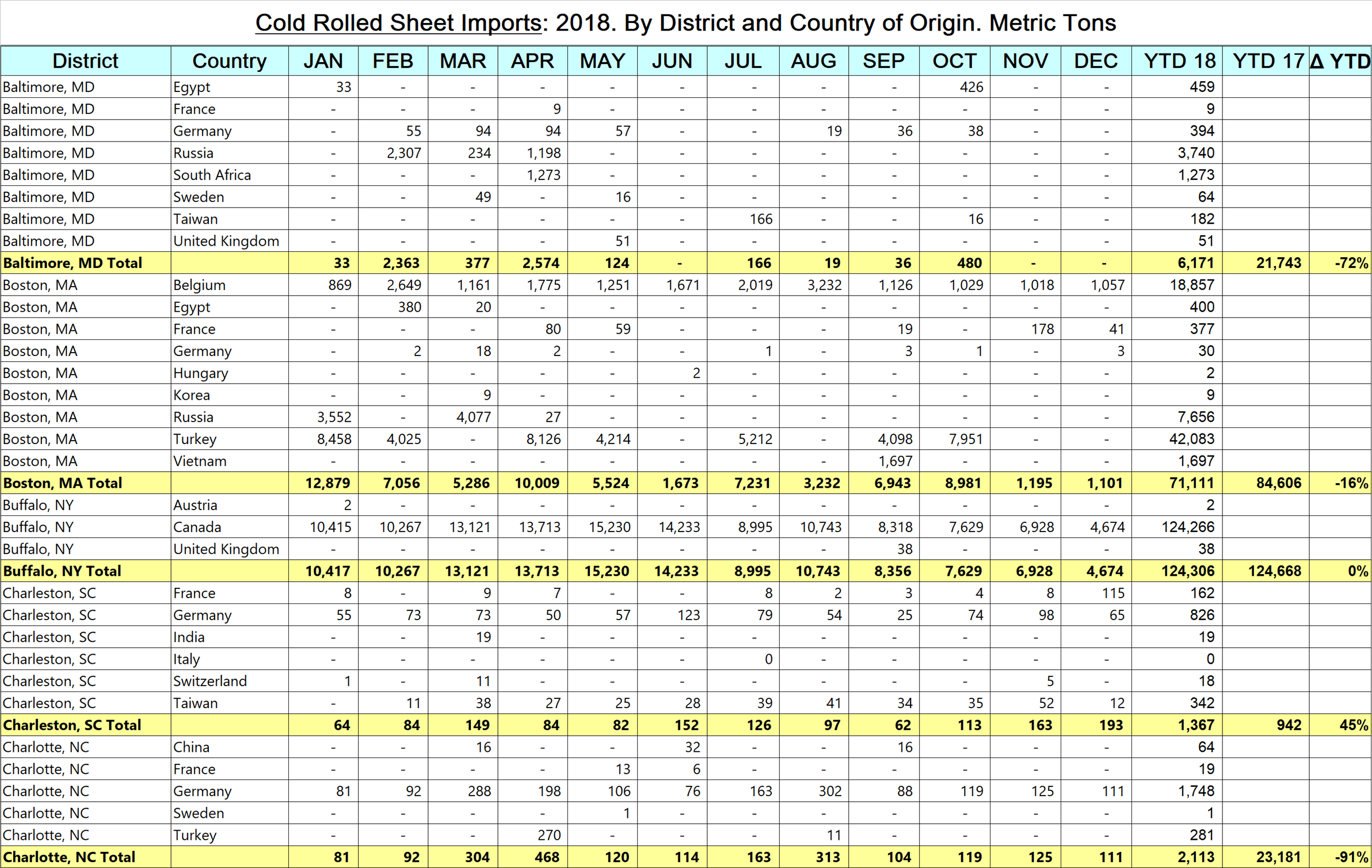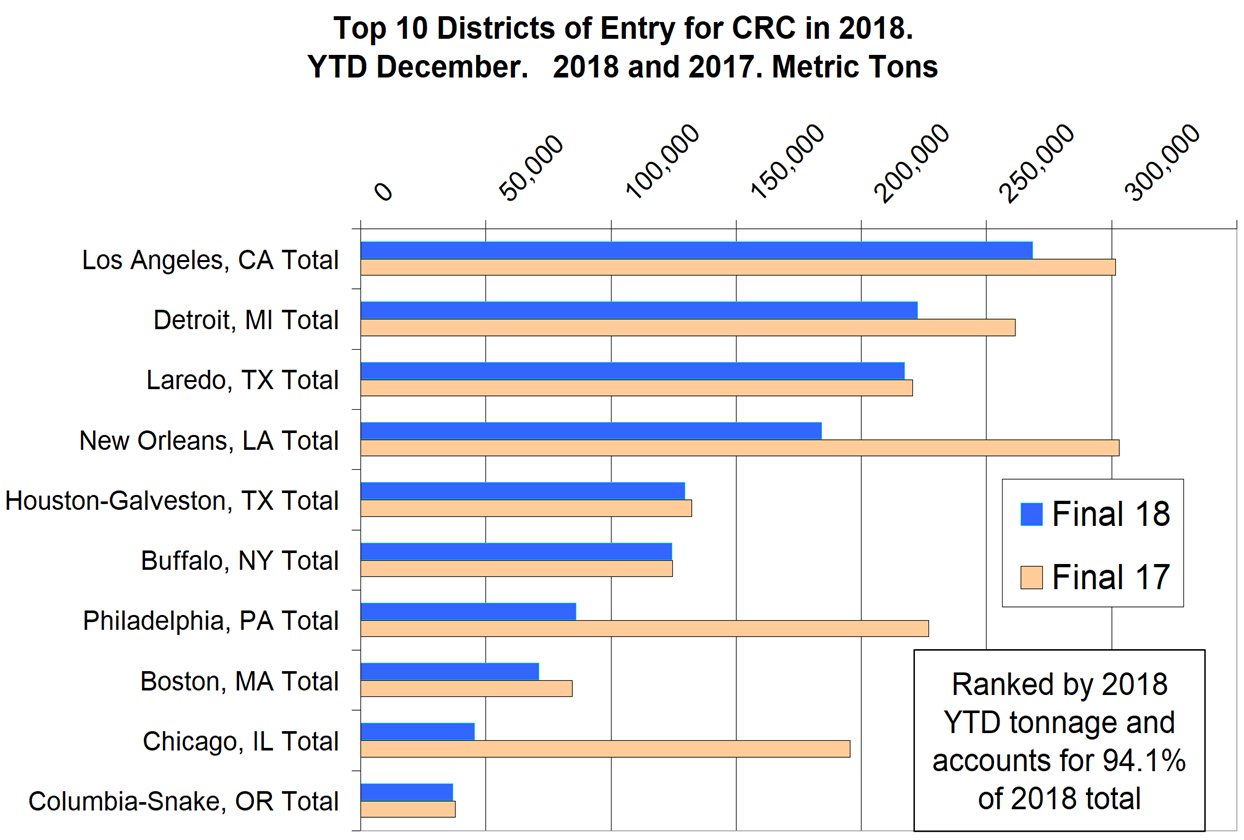Steel Products Prices North America

Hot and Cold Rolled Sheet Imports by District of Entry and Source Nation, December 2018
Written by Peter Wright
March 14, 2019
Steel Market Update is sharing the following Premium-level content on flat rolled imports with Executive-level members. For more information about upgrading to a Premium-level subscription, contact info@steelmarketupdate.com.
Finally, the detailed steel trade data has been released for December. Again, we apologize for our lack of trade reports in the last few months. August was the last detailed data that we reported. The September results should have been released in early November, but the USITC had scrapped and re-built their DataWeb and the new program didn’t work. We and no doubt others worked with them for many hours in November and December as they tried to fix the problem. Then came the government shutdown. Finally, last Friday, the December data was released and the DataWeb functioned reasonably well. Recovery from the shutdown is still not complete. At this stage in March we should have January’s results. At SMU, we still have the problem of rebuilding queries in the new DataWeb, so it will likely be another month before all our trade reports are back up and running.
![]() This analysis breaks down the imported tonnage of hot and cold rolled sheet into the district of entry and the source country. We believe that misinformation (or lack of) about local import volumes is often used to influence purchase decisions. Our intent with this analysis is to describe in detail what is going on in a company’s immediate neighborhood and thus provide a negotiating advantage for our premium subscribers.
This analysis breaks down the imported tonnage of hot and cold rolled sheet into the district of entry and the source country. We believe that misinformation (or lack of) about local import volumes is often used to influence purchase decisions. Our intent with this analysis is to describe in detail what is going on in a company’s immediate neighborhood and thus provide a negotiating advantage for our premium subscribers.
Premium members have access on our website to analyses that break down the import tonnage through December into the port of entry and country of origin in metric tons. Normally, products analyzed in this way are HRC, CRC, HDG sheet, OMC sheet, CTL plate and coiled plate. At this time, we can report only HRC and CRC. Next month we should have all six products back up and running. This data set is large; therefore, we will make no attempt to provide a commentary. Each reader’s interest will be different and he or she simply needs to select one of the products, then find the nearest port or ports of entry to see how much came into their locality each month, where it came from and most importantly how the local import volume has changed year-over-year. Monthly data is provided back to January 2016. It is clear from these detailed reports and from our companion reports by region that the change in tonnage entering a particular district in most cases is completely different from the change in volume at the national level.

Here are some examples to illustrate why this information can be actionable: Total cold rolled sheet imports for 2018 as a whole were down by 28 percent from 2017. Baltimore was down by 72 percent and New York was up by 16 percent. Examples like these are to be found throughout the two updated reports by product. The discrepancy between the change at the national and local levels is why we think it’s important for both market understanding and negotiating position to know what’s going on in your own backyard.
The table included here is a small part of the detailed analysis of the CRC sheet tonnage. The bar graph shows the tonnage that entered the top 10 districts through December for 2017 and 2018 ranked by 2018 tonnage. These 10 districts accounted for 94.1 percent of the total in 2018 tonnage. Los Angeles had the most volume in 2018 and was down by 11 percent compared to 2017. Australia has been by far the highest volume source into LA in 2018, followed by Vietnam and Russia.

The data in these detailed reports is compiled from tariff and trade data published by the U.S. Department of Commerce and the U.S. International Trade Commission (USITC). Our national level import reports are sourced from U.S. Department of Commerce, Enforcement and Compliance, aka the Steel Import Monitoring System. In the development of these reports by district and source country, we have discovered that the SIMA data for HRC and CRC contains some high-alloy steels such as stainless and tool steel, which have been misclassified at the ports. These alloy steels are not included in our detailed reports, which results in a small discrepancy between the two data sets, for CRC in particular and for HRC to a lesser degree.

Peter Wright
Read more from Peter WrightLatest in Steel Products Prices North America

Nucor slows HRC price climb with $5/ton increase
After eight weeks of double-digit price increases on hot-rolled (HR) coil, Nucor slowed the price rise this week with an increase of $5 per short ton.

Domestic CRC prices surge ahead of imports
The price spread between stateside-produced CR and imports reached its widest margin in over a year.

Evraz raises plate prices $160/ton
Evraz North America (NA) has followed Nucor and SSAB with a plate price increase of its own: up $160 per short ton (st). The increase was effective immediately for all new orders of carbon, high-strength low-alloy, and normalized and quenched-and-tempered plate products, as well as for hot-rolled coil, the steelmaker said in a letter to […]

Nucor lifts HR coil to $820/ton
Nucor has increased its consumer spot price (CSP) for hot-rolled (HR) coil for a fourth consecutive week.

Nucor pushes HR spot price to $790/ton
Nucor increased its consumer spot price (CSP) for hot-rolled (HR) coil to $790 per short ton (st) on Monday, Feb. 10 – a $15/st bump vs. last week. The Charlotte, N.C.-based company has raised its weekly CSP by $40/st over the past three weeks after maintaining tags at $750/st since Nov. 12, according to SMU’s […]
